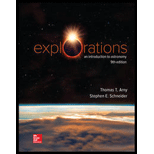
Loose Leaf For Explorations: Introduction To Astronomy
9th Edition
ISBN: 9781260432145
Author: Thomas T Arny, Stephen E Schneider Professor
Publisher: McGraw-Hill Education
expand_more
expand_more
format_list_bulleted
Textbook Question
Chapter 10, Problem 4TQ
Approximate the Roche limit as 2.44 times a planet’s radius. Using appendix tables 3 and 5, calculate the Roche limit distances for Saturn and Uranus and make a list of the moons found inside these distances. How it is possible for these moons to orbit there? Would you expect these moons to be spherical or irregular? Why?
Expert Solution & Answer
Want to see the full answer?
Check out a sample textbook solution
Students have asked these similar questions
What is the observed angular speed of
Neptune, along the ecliptic of Earth, when it is
at opposition, in units of arc minutes / day?
Presume the orbits are circular. Earth has
orbital speeds of 30km/s and Neptune has
5.43km/s, Neptune here has orbital radius
30.1 AU. Now looking at Uranus for the same
condition, in what direction along the ecliptic
will it be traveling?
I would like you to compare the size of some of the largest moons of the solar system to their host planets. Using diameters of 12,700 km, and 140,000 km, 116,000 km for Earth, Jupiter, and Saturn respectively, please provide the ratios of the following moons to their host planets (you can use Table 12.1 from the book to get the diameters of the moons): Luna (Earth's moon), Io, Callisto, Ganymede, Europa, and Titan. After collecting those ratios, please tell me one thing that you notice that stands out about those results.
GM
What is the orbital velocity and period of a ring particle at the outer edge of Saturn's A ring? (Note: The radius of the edge of the A ring is 136,500 km. Hint: Use the formula for orbital velocity, V. = v
orbital velocity
km/s
period
hr
Chapter 10 Solutions
Loose Leaf For Explorations: Introduction To Astronomy
Ch. 10 - Prob. 1QFRCh. 10 - What does Jupiter look like?Ch. 10 - How do astronomers know what lies inside the outer...Ch. 10 - What are the major gaseous substances that make up...Ch. 10 - What is the interior structure of Jupiter and...Ch. 10 - Do Jupiter and Saturn have solid surfaces?Ch. 10 - Prob. 7QFRCh. 10 - Prob. 8QFRCh. 10 - What sort of activity has been seen on Io? What is...Ch. 10 - What are the rings of Saturn made of? How do...
Ch. 10 - Prob. 11QFRCh. 10 - Prob. 12QFRCh. 10 - Prob. 13QFRCh. 10 - What is unusual about Uranuss rotation axis? What...Ch. 10 - Prob. 15QFRCh. 10 - Why are Uranus and Neptune so blue?Ch. 10 - Why are the outer planets so large?Ch. 10 - Prob. 18QFRCh. 10 - Prob. 1TQCh. 10 - Prob. 2TQCh. 10 - Ganymede and Callisto orbiting Jupiter and Tethys...Ch. 10 - Approximate the Roche limit as 2.44 times a...Ch. 10 - Prob. 5TQCh. 10 - (10.3) Is Uranuss sky blue for the same reason our...Ch. 10 - Prob. 7TQCh. 10 - Prob. 8TQCh. 10 - Prob. 9TQCh. 10 - Prob. 10TQCh. 10 - Prob. 1PCh. 10 - Prob. 2PCh. 10 - Prob. 3PCh. 10 - Prob. 4PCh. 10 - Prob. 5PCh. 10 - Prob. 6PCh. 10 - Prob. 7PCh. 10 - Prob. 8PCh. 10 - (10.1) The low average densities of Jupiter and...Ch. 10 - Prob. 2TYCh. 10 - Prob. 3TYCh. 10 - Prob. 4TYCh. 10 - Prob. 5TYCh. 10 - Prob. 6TYCh. 10 - Prob. 7TY
Knowledge Booster
Learn more about
Need a deep-dive on the concept behind this application? Look no further. Learn more about this topic, physics and related others by exploring similar questions and additional content below.Similar questions
- Present theory suggests that giant planets cannot form without condensation of water ice, which becomes vapor at the high temperatures close to a star. So how can we explain the presence of jovian-sized exoplanets closer to their star than Mercury is to our Sun?arrow_forwardThe ring systems around Jupiter and Saturn lie outside those planets respective Roche limits. True or false? How do you know?arrow_forwardWhat is the maximum angular diameter of Uranus as seen from Earth? Of Neptune? (Hint: Use the small-angle formula, Eq. 3-1.) (Note: Necessary data are given in their Celestial Profiles.)arrow_forward
- Saturns rings are primordial, meaning that they originated when the planet formed. True or false? How do you know?arrow_forwardWhy do you think the outer planets have such extensive systems of rings and moons, while the inner planets do not?arrow_forwardPart 2 of 3 The Roche limit for Jupiter is given by: R = 2.44r R = km Submit Skip (you cannot come back)arrow_forward
- What is the orbital speed, in kilometers per second, of ring particles at the inner edge of Saturn's B ring?arrow_forwardCalculate the escape velocity to an orbit of 243 km height from a planet with the radius of 2000 km and the density of 3400 kg m-³. Give your answer in Sl units. Answer: Choose...arrow_forward
arrow_back_ios
arrow_forward_ios
Recommended textbooks for you

 Foundations of Astronomy (MindTap Course List)PhysicsISBN:9781337399920Author:Michael A. Seeds, Dana BackmanPublisher:Cengage Learning
Foundations of Astronomy (MindTap Course List)PhysicsISBN:9781337399920Author:Michael A. Seeds, Dana BackmanPublisher:Cengage Learning AstronomyPhysicsISBN:9781938168284Author:Andrew Fraknoi; David Morrison; Sidney C. WolffPublisher:OpenStax
AstronomyPhysicsISBN:9781938168284Author:Andrew Fraknoi; David Morrison; Sidney C. WolffPublisher:OpenStax
 An Introduction to Physical SciencePhysicsISBN:9781305079137Author:James Shipman, Jerry D. Wilson, Charles A. Higgins, Omar TorresPublisher:Cengage Learning
An Introduction to Physical SciencePhysicsISBN:9781305079137Author:James Shipman, Jerry D. Wilson, Charles A. Higgins, Omar TorresPublisher:Cengage Learning


Foundations of Astronomy (MindTap Course List)
Physics
ISBN:9781337399920
Author:Michael A. Seeds, Dana Backman
Publisher:Cengage Learning

Astronomy
Physics
ISBN:9781938168284
Author:Andrew Fraknoi; David Morrison; Sidney C. Wolff
Publisher:OpenStax


An Introduction to Physical Science
Physics
ISBN:9781305079137
Author:James Shipman, Jerry D. Wilson, Charles A. Higgins, Omar Torres
Publisher:Cengage Learning
Kepler's Three Laws Explained; Author: PhysicsHigh;https://www.youtube.com/watch?v=kyR6EO_RMKE;License: Standard YouTube License, CC-BY